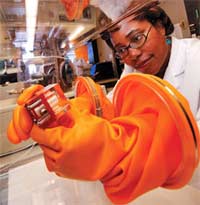A group of engineers at MIT has developed a new type of membrane for one type of fuel cell which they claim could improve power output by more than 50 per cent.
The new material is considerably less expensive than its conventional industrial counterpart, and could help fuel cells to find a much broader market, particularly in portable electronics.
"Our goal is to replace traditional fuel-cell membranes with these cost-effective, highly tuneable and better-performing materials," said Paula T. Hammond, Bayer Professor of Chemical Engineering at MIT, and leader of the research team.
The team focused on direct methanol fuel cells (DMFCs) in which the methanol is directly used as the fuel. Reforming of alcohol down to hydrogen is not required.
Such a fuel cell is attractive because the only waste products are water and carbon dioxide, the latter produced in small quantities.
Also, because methanol is a liquid, it is safer and easier to store and transport than hydrogen gas.
However, DMFCs on the market have limitations as the material currently used for the electrolyte, known as Nafion, is expensive.
Furthermore Nafion is permeable to methanol allowing some of the fuel to seep across the centre of the fuel cell, thereby wasting fuel and lowering the efficiency of the cell.
Using a relatively new technique known as layer-by-layer assembly, the MIT researchers created an alternative to Nafion which is two orders of magnitude less permeable to methanol but compares favourably to Nafion in proton conductivity.
To test their creation, the engineers coated a Nafion membrane with the new film and incorporated the whole into a direct methanol fuel cell. The result was an increase in power output of more than 50 per cent.
The team is now exploring whether the new film could be used by itself, completely replacing Nafion.
Hammond noted that the new material also has potential for use in other electrochemical systems such as batteries, and that the team has begun exploring the new material's potential use in photovoltaics.

